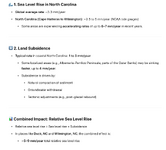- Banned
- #1
OK, be gentle, not an engineer. Only a gorblimey chippie, by trade...so understand nothing...much...but am aware that climate change effects are becoming more visible and more regular, leading to a greater than historic frequency of repeat inundations in riverine and coastal environments.
What I'd like to understand is whether or not it might be feasible to turn 'lightweight timber structures' like older-style timber framed, timber-clad dwellings, into 'houseboats' as a means of avoiding repetitive flood inundation (as per Lismore NSW in recent years).
As a boat owner, and marina user occasionally, I'm familiar with the modern 'marina construction' methodology of driven piles and floating pontoons.
Would it be possible to place similar driven piles (maybe vibration driven) around such dwellings, jack them up, add floatation chambers to the sub-structure (possibly even add a RHS steel sub-structure to prevent twisting), and attach 'rollers' at the pile attachment points, to enable such homes to simply *rise and fall* with the floodwaters..?
OK, so I know my thumbnail sketch is a massive over-simplification of what would need to occur to make this work but....could it work...??
My best guess on house mass is between 4-10 tonnes. So would 4000-10000L of buoyancy be enough to float that...??? Even if double that was necessary, a 1.0m X 1.0m X 10m rotomoulded floatation chamber would contain 10,000L, so two of them, either side of the dwelling...?? [This is wet thumb in the breeze guesswork, so probably hopelessly inadequate...]
I'm not even remotely close to being a mathematician, so cannot hazard more than a guess at whether this might even be possible, so am wondering if there are engineers here willing to respond - kindly - and without scoffing *too* loudly at my 'below the salt' hypothesis....????
It seems to me, from the $$$numbers various agencies have been floating about, that there is a LOT of expenditure on new, greenfields land, and new-built housing to 'replace' so-called flood-affected housing. Maybe $500-800K per dwelling. What might the 'cost per pile' be for, let's say, 500mm diameter 10m long R/C driven piles...?? Especially if, as seems to be the case, there could be a lot of 'ongoing work' in localised areas, enabling some degree of 'scale' to be factored in.
I'm wondering whether there is enough in that to interest a piling engineering firm to perhaps investigate the feasability of 'floating the boat' rather than removing the dwelling and destroying the existing community....??
I mean, thousands of homes along every river and coastline....with a successfully designed 'floatation system' potentially being a 'development condition' for future dwellings in flood-risk areas.....
There's certainly, I think, some potential there, if someone could work out a cost-effective 'system'...??
Now, I'll just don my flame-proof overalls, and duck behind this heatshield......
Anyone care to enlighten me? Politely? Tx in advance.
What I'd like to understand is whether or not it might be feasible to turn 'lightweight timber structures' like older-style timber framed, timber-clad dwellings, into 'houseboats' as a means of avoiding repetitive flood inundation (as per Lismore NSW in recent years).
As a boat owner, and marina user occasionally, I'm familiar with the modern 'marina construction' methodology of driven piles and floating pontoons.
Would it be possible to place similar driven piles (maybe vibration driven) around such dwellings, jack them up, add floatation chambers to the sub-structure (possibly even add a RHS steel sub-structure to prevent twisting), and attach 'rollers' at the pile attachment points, to enable such homes to simply *rise and fall* with the floodwaters..?
OK, so I know my thumbnail sketch is a massive over-simplification of what would need to occur to make this work but....could it work...??
My best guess on house mass is between 4-10 tonnes. So would 4000-10000L of buoyancy be enough to float that...??? Even if double that was necessary, a 1.0m X 1.0m X 10m rotomoulded floatation chamber would contain 10,000L, so two of them, either side of the dwelling...?? [This is wet thumb in the breeze guesswork, so probably hopelessly inadequate...]
I'm not even remotely close to being a mathematician, so cannot hazard more than a guess at whether this might even be possible, so am wondering if there are engineers here willing to respond - kindly - and without scoffing *too* loudly at my 'below the salt' hypothesis....????
It seems to me, from the $$$numbers various agencies have been floating about, that there is a LOT of expenditure on new, greenfields land, and new-built housing to 'replace' so-called flood-affected housing. Maybe $500-800K per dwelling. What might the 'cost per pile' be for, let's say, 500mm diameter 10m long R/C driven piles...?? Especially if, as seems to be the case, there could be a lot of 'ongoing work' in localised areas, enabling some degree of 'scale' to be factored in.
I'm wondering whether there is enough in that to interest a piling engineering firm to perhaps investigate the feasability of 'floating the boat' rather than removing the dwelling and destroying the existing community....??
I mean, thousands of homes along every river and coastline....with a successfully designed 'floatation system' potentially being a 'development condition' for future dwellings in flood-risk areas.....
There's certainly, I think, some potential there, if someone could work out a cost-effective 'system'...??
Now, I'll just don my flame-proof overalls, and duck behind this heatshield......
Anyone care to enlighten me? Politely? Tx in advance.

